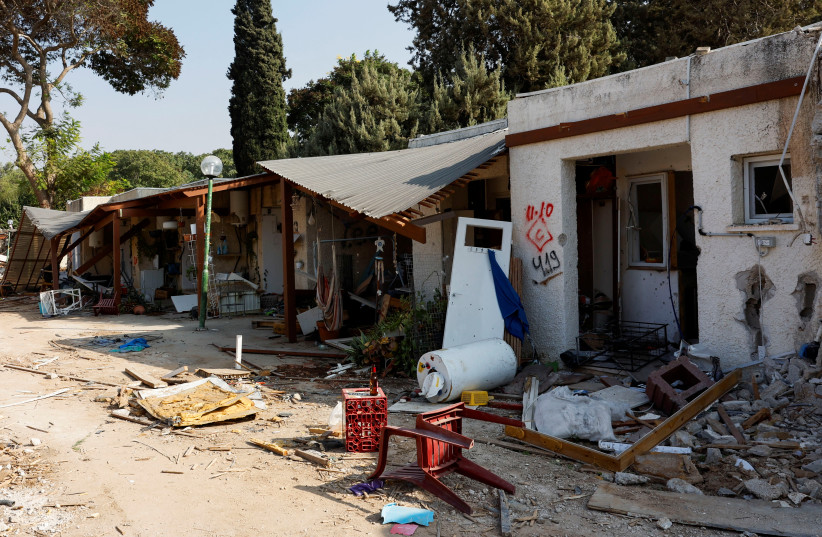Only five Hamas leaders knew the full scope of the October 7 invasion plan, and they only made the final decision to attack on that Saturday the day before, according to a new report in Asharq Al-Awsat.
The report, which said it was based on Palestinian sources closely associated with the leadership of the Al-Qassam Brigades, stated that the decision and timing of the attack were reportedly made by only five individuals: Yahya Sinwar, Hamas leader in Gaza; Muhammed Deif, leader of the Al-Qassam Brigades, Muhammed Sinwar (Yahya’s brother), Rouhi Mushtaha, a Hamas leader close to Sinwar, and Ayman Nofal, a close associate of Deif and former head of Al-Qassam Brigades’ intelligence, assassinated by Israel on October 17.
Surprisingly, the list did not include Hamas leader Ismail Haniyeh, Hamas deputy leader Saleh al-Arouri (recently allegedly assassinated by Israel), or Marwan Issa, considered a key part of Hamas’s internal triumvirate within Gaza currently running its war and hostage efforts.
The surprise attack launched by Hamas resulted in the brutal murders of over 1,200 Israelis, mostly civilians, and the abduction of around 240 Israelis, while Hamas initially took over 22 Israeli villages and the IDF’s forward southern command base at Reim.
According to the report, what it calls “The Al-Aqsa Flood operation” began with just 70 fighters, launching a surprise attack along the entire Gaza Strip border, from north to south.

These 70 crossed the Israeli border by strategically exploding prepared explosives to breach the thick walls of the Gaza-Israel barrier.
Next, they used motorized hang gliders and parachutes to position fighters behind, above, and around Israeli sites.
The plan for the attack is dated back to 2014
According to the report, those involved in the operation were selected from Hamas’s elite units across various areas in Gaza, having undergone extensive training over the years – without knowing exactly what they were training for.
In fact, the report claims that the plan to invade Israel is not new but dated back to before the 2014 Gaza conflict and was revisited and updated after the 2021 Gaza conflict.
After receiving confidential training, elite members pledged secrecy about their special training and refrained from discussing plans, while at the same time, they still did not even know the timing or full scope of the plans.
Their training was especially focused on infiltrating Jewish villages in the South.
Further, the report said that even many senior Hamas field commanders' areas were unaware of attack details or plans, although some had limited information, to the extent that information was relevant to their specific tasks.
All this extreme secrecy was targeted at preventing leaks to Israeli intelligence, said the report.
Although the IDF did discover aspects of the plans, it did not discover the seriousness of the plans and discounted them as a Hamas “pipedream,” and not something which actually needed to be countered.
If the report is correct, part of why Israeli intelligence likely discounted the scenario is because it had existed since 2014 and had never been carried out.
According to the report, the five top leaders informed Al-Qassam Brigades’ unit leaders about the preparations and the attack plan about three days before, signaling something was more likely afoot, but even then, they did not decide or mention their thoughts on the exact timing.
At this point, field commanders started to more carefully prepare their selected forces, though the timing of the attack was still unknown.
Around this time, the report said that Ayman Siyam, the leader of the Gaza rocket unit (also assassinated by the IDF), was finally very belatedly brought into the loop and received instructions to be ready to launch hundreds of rockets simultaneously with the attack.
Ultimately, Hamas fired over 3,000 rockets in the first four hours of the war.
When October 7 was selected by the panel of five, it was based on real-time reports of a sleepy clam descending on the borders, said the report.
Only on October 6, the day before, noted the report, did the panel of five decide on Saturday morning as the time when the IDF’s guard would be at its lowest due to the Simchat Torah holiday.
Carrying out the plan
At midnight that night, they finally gave the order to move into position to take action, the report recounted.
Hamas field commanders and elite forces received instructions and moved into position in the early morning hours, marking the start of the operation.
According to the report, a wider group of Hamas leaders received a briefing just hours before the operation, instructing them to go into hiding in preparation for a likely intense IDF response. This was the first time that Haniyeh and Arouri were given more specific details.
Originally, the report said that Hamas’s plan was just to capture as many soldiers as possible on the border and possibly to get into some villages.
But the report said that Hamas was surprised at how quickly Israeli defenses crumbled and, in real-time, around 90 minutes into the attack, ordered additional waves of forces to take greater advantage of the breach in Israeli security to get into more villages.
Even later, Hamas told Islamic Jihad and other terror groups about the attack and gave them specific tasks to join in at specific villages.
Later, the report said that Hamas also encouraged less trained groups of militia-style fighters to join the fray.
However, the focus of Hamas’s operation remained to kidnap as many Israelis as possible, and the rest of the attacks were designed to give cover for that goal, the report said.
